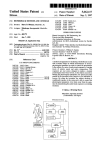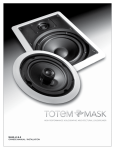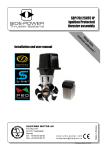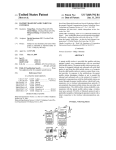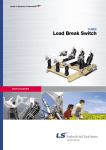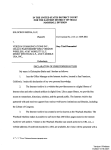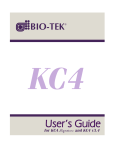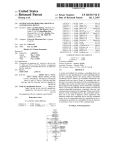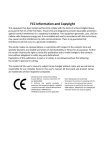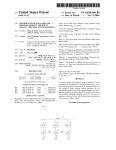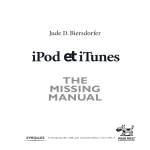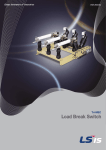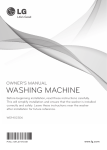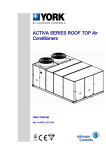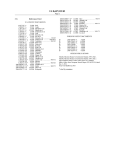Download Method and apparatus for biofeedback
Transcript
. US005343871A Unlted States Patent [191 [11] Patent Number: Bittman et a]. [45] [54] Sep. 6, 1994 METHOD AND APPARATUS FOR 4,896,675 l/ 1990 Ohsuga et a1. .................... .. 128/671 4,919,143 4/1990 Ayers .. . .. ..... .... . . . .. 128/732 4,928,704 5/ 1990 Hardt . .. ....... . .. . . . . .. 128/732 Assignee: 4,932,880 6/ 1990 Kotick et a1. 128/715 Jeffrey R_ cram, Nevada city, calig 4,984,158 1/1991 Hillsman ....... .. 5,024,235 6/1991 Ayers Mindscope Incorporated, Meadville, 5,036,858 8/1991 Carter et a1. . . . . Pa. 5,076,281 12/1991 [21] APPL No‘, 850,673 364/413.04 . . . . . . .. . . . . . . . . . .. 128/732 . . . .. 128/732 Gavish .............................. .. 128/721 Primary Examiner-William E. Kamm _ Assistant Examiner-Scott M. Getzow [22] Flledl Mar- 13, 1992 Attorney, Agent, or Firm-Webb, Ziesenheim, Bruening, [51] Int. Cl.5 .............................................. .. A61B 5/02 [52] US. Cl. .................................. .. 128/732; 128/905; L°gsd°m Ork‘“ 8‘ Hans” [57] ABSTRACT 128/670' 128/733 A method and apparatus for medlatmg a blofeedback Field of Search .............. .. 128/905, 732, 670, 733 References Cited Session with a human subject in which measurements of electrophysiological quantities are used to control the presentation to the subject of a series of prestored audio visual sequences of varying levels of clarity resident on _ [58] [56] Date of Patent: BIOFEEDBACK [75] Inventors: Barry B. Bittman, Meadville, Pa.; [73] 5,343,871 . ’ U'S' PATENT DOCUMENTS 3,837,331 9/1974 Ross .................................. .. 128/1 C 3,355,998 12/ 1974 Hidalgo-Bliccno 128/2-1 B S11v3 et a1. ...... .. . . a direct-access video storage device. The sequences are real scenes designed to induce a desired psychological ... 3,916,876 11/1975 Freeman ..... .. 128/2.1 M B Statephysiological his when viewed.parameters’ As the the clarity succeeds ofinthe pres_ 3,942,516 3/1976 Glynn et al. .. 128/2.1 B 128” C ented lmage and sound lmprove as an mdicatlon of 3’978’847 9/1976 ' '' ' ' ' ' ' ‘ "128/2 1 B success. By using the invention, the subject develops a " “(V148 ..... .. 340/148 his Physiological Parameters even when away from the 3 967 616 7/1976 R 4:056:805 11 A977 Brady ““““ 4,140,997 2/1979 Brady . _ . . . . conditioned response to the scenes and is able to control 4,354,505 10/1932 shiga , . _ _ . _ , _ _ _ ,_ 128/732 apparatus by remembering the audio-visual sequences 4,461,301 7/1984 Ochs . . . . . . . . . . . . . . . . . . . .. 128/630 used during treatment. 4,665,926 5/1987 Leuner et a1 . . . . . 1. 128/716 4,683,891 8/1987 Cornellier et a1. 4,776,323 4,823,808 10/1988 Spector . ... . ..... .. 128/630 ..... ... .. ... . . . .. 4/1989 Clegg et a1. . 20 Claims, 2 Drawing sheets 128/25 B ' ..... .. 128/773 _ Micro?che Appendix Included 4,883,067 11/1989 Knispel et a1 .................... .. 128/732 (2 Micro?che, 111 Pages) BIOFEEDBACKAPPARATUS _ ________________ __ 107 1 __ _ 7 7 _ _ '“1 11L | w 1 : 1 1 LEFT SPEAKER /_—_ : I 1 7°7 6°? | I : VISUAL VIDEO DISPLAY I PLAYER : 1 | 1s 1 1 I \_1w_ 1 ] RIGHTSPEAKER i I /——— : 207 : BIOFEEDBACK P 1 1 1 : 307 I l 1 DIG'TAL 11135681021128 : I COMPUTER : 1 1 I 1 I 1 1 l | | | 1 | | 407 COMPUTER i 5°? KEYBOARD GRAPHIC MONITOR 457 LAS ER PRINTER 1 I l l l | 1 1 1 US. Patent ’ Sep. 6, 1994 Sheet 1 of2 5,343,871 BIOFEEDBACK APPARATUS 10-7 I I l I I I I I I I I I 11L MEL‘ LEFT SPEAKER 707 I I VISUAL VIDEO DISPLAY PLAYER I I I I ' I 15 207 BIOFEEDBACK PREAMPLIFIER AND CONVERTER I I l I I I l I I I I I l I I I I I I | I I I I I I I RIGHT SPEAKER l I I I I I I I I I I l I I I I / I 30; DIGITAL COMPUTER 407 COMPUTER KEYBOARD 507 GRAPHIC MONITOR 457 LASER PRINTER I I I I I I I I I I I I I I I I I I I l I _--______—______—____-___-_~ U.S. Patent Sep. 6, 1994 Sheet VIDEODISC 2 of 2 100,7 CLUSTER 1107 LVRI 1 LVRI 2 LVRI 3 LVRI 4 LVRI 5 111 D2 115 1.13. 11-5 Fig. 3. 1 5,343,871 2 signals from the subject, is not a biofeedback device METHOD AND APPARATUS FOR BIOFEEDBACK because the subject is not guided by stimuli to modify his own physiological parameters. Cornellier et al. U.S. Pat. No. 4,683,891 teaches use of a visual display to 5 indicate the values of a subject’s physiological parame Two micro?che appendices are provided. Micro?che Appendix A comprises 46 frames on micro?che 1 of 2. Micro?che Appendix B comprises 56 frames on micro ?che 2 of 2. ters at the point where stress is induced during perfor mance of a goal-oriented task. A number of prior art biofeedback devices employ BACKGROUND OF THE INVENTION 1. Field of the Invention purely audio feedback to the subject. Silva et al. U.S. 10 Pat. No. 3,875,930 teaches using a fixed audio signal that This invention relates to a method of mediating a decays to silence as an indication that the desired brain biofeedback session with a human subject in which wave waveform has been achieved. Spector U.S. Pat. measurements of certain of the subject’s electrophysio No. 4,776,323 teaches playing sounds through head logical parameters are used to control the presentation phones to induce relaxation in a subject for the purpose to the subject of a series of prestored audio-visual se 15 of creating a calm state that can then be interrupted by quences of varying levels of clarity or perspective to high-amplitude noises to cause stress. Knispel et al. U.S. provide targets whose viewing induces in the subject a Pat. No. 4,883,067 teaches a method of transforming desired psychological state. 2. Description of the Prior Art brainwave activity into musical sound, which is fed back to the subject via headphones. Biofeedback is a process in which electrodes are con 20 nected to a human subject to monitor electrophysiologi cal parameters such as heart rate, electroencephalo Numerous prior art devices combine audio and visual feedback Glynn et a1 U.S. Pat. No. 3,942,516 teaches simultaneous monitoring of a plurality of electrophysio logical parameters to produce a single audio-visual out put for feedback. Fehmi et al. U.S. Pat. No. 3,978,847 graphic signals and galvanic skin resistance. These sig nals are converted to a visual or audio display that can been seen and/or heard by the subject, who attempts to 25 teaches using audio tones and a light that increases in alter the parameters using the display as a guide to his amplitude and stroboscopic frequency as the frequency progress. If it is desirable to reduce blood pressure, for of the subject’s brainwaves increases. Clegg et al. U.S. example, the display may consist of a bar graph indicat Pat. No. 4,823,808 teaches a method for treating eating ing the magnitude of the pressure. If the subject is suc disorders by measuring parameters of the gastrointesti cessful in lowering his blood pressure, he will see the 30 nal tract and providing indications of gastric activity by size of the bar diminish and will thus know he is making visual and audio means, as by amplifying stomach progress. noises. Ohsuga et al. U.S. Pat. No. 4,896,675 teaches Traditional biofeedback methods employ such mech providing graphs of physiological parameters and si anisms as analog meters, computer-generated displays, multaneously generating a sound pattern to be used by targets shown in cross-hairs, acoustic tones and audio 35 the subject to control his rate of respiration. Ayers U.S. beat frequencies to indicate to the subject the values of Pat. Nos. 4,919,143 and 5,024,235 teach a sound and the parameters being monitored. light box in addition to graph waveforms as output from Biofeedback is commonly performed by a biofeed a biofeedback system. Hardt U.S. Pat. No. 4,928,704 back technician, who directs the subject verbally to teaches combining tone feedback with display of digital achieve a state of calm by coaching him to develop a 40 data to the subject. Hillsman U.S. Pat. No. 4,984,158 mental image of a relaxing scene. Unfortunately, it can teaches auditory prompts and use of visual graphs for be difficult to relax during such a session because the instructing subjects to use a metered dose inhalation subject is forced to concentrate on a computer display system. Carter et al. U.S. Pat. No. 5,036,858 teaches use or audio tone to gauge his progress. That is, the result or of light goggles and headphones to convey beat signals display viewed by the subject is not in itself calming, 45 to a subject indicative of how much his brainwave fre and may actually interfere with the desired objective. quency differs from a desired frequency. Gavish U.S. Biofeedback can be used to treat migraine and tension Pat. No. 5,076,281 teaches using synthesized sound headaches, pain disorders such as temporomandibular patterns and optical effects indicative of parameters of joint dysfunction (TMJ) and myofascial syndromes, musculoskeletal tension, hypertension, anxiety and panic disorders, asthma, dyspepsia, and other conditions biorhythmic activity. 50 that can be controlled by reducing muscular tension, inducing a state of calm or stabilizing autonomic func- ' tion. Biofeedback can be used both for treatment and prevention of such syndromes. Biofeedback devices and methods comprising visual displays are known in the prior art. Ross U.S. Pat. Nos. 3,837,331 and 3,967,616 teach use of a “transducing means” for exhibiting sensory signal output to the human subject, which may include a matrix of num bered lamps, slides projected on a screen, or an audible 55 Freeman U.S. Pat. No. 3,916,876 teaches measure ment‘of muscle tension in two selected muscles while the subject watches electrical meters displaying the tension measurements and other quantities derived from them. There is no audio or visual feedback other than meter readings. Brady U.S. Pat. Nos. 4,056,805 and 4,140,997 disclose a video display comprising a matrix of colored lights that is controlled in response to brainwaves. Brady’s invention does not comprise a biofeedback system, but is directed to conveying a visual indication of a subject’s response to sound, particularly music. Shiga U.S. Pat. No. 4,354,505 teaches measurement of the length of closes an entertainment device that monitors electro time a subject has remained in a relaxed state by display physiological parameters of a human subject and pres ing numerals indicative of the said length. Ochs U.S. ents “audio-visual stimulation” comprising passages of 65 Pat. No. 4,461,301 teaches display of numerical indica music, ?ashing lights or projected images intended to tions dependent on the values of monitored electro place the subject in a desired psychological state. The physiological parameters. Leuner et al. U.S. Pat. No. Hidalgo-Briceno invention, while it receives electrical 4,665,926 teaches a system for measuring a person’s chime. Hidalgo-Briceno U.S. Pat. No. 3,855,998 dis 3 5,343,871 relaxation state, but in which displayed information is not fed back to the subject but is instead monitored by 4 prestored audio-visual scenes at varying levels of visual and acoustic clarity. The scenes themselves are of plea surable images designed to induce relaxation, such as a technician. It is a drawback of prior art biofeedback devices and views of beaches with rolling surf, lush ?ower gardens, methods that the feedback provided to the subject is merely a display of values of physiological parameters a sunset, a waterfall and the like. As the subject gradu or an indication of how successful the subject has been becomes progressively enhanced. The “reward” to the in achieving his goal. They do not provide a target, subject for approaching the desired state is a succes sively clearer image, closer view or movement of an ally attains the desired physiological state, the image desirable in itself, to assist in the attainment of success. In fact, the prior art devices utilize feedback means that can actually interfere with the desired objective by object. In this way, the subject is able to perform bio feedback without the distraction of prior art feedback forcing the subject to concentrate on a wave tracing, ?ashing light or blip on an oscilloscope screen in order ing. Subsequent to the treatment, the subject is able to indicators, which are not themselves relaxation induc to gauge his progress. In prior art methods, the subject must generally be coaxed by an assistant into imagining induce a relaxed state in himself by recalling the scenes used during treatment. a relaxing scene or locale in order to alter his electro BRIEF DESCRIPTION OF THE DRAWINGS FIG. 1 shows a block diagram of the apparatus of the physiological responses. The following are objects of the present invention: 1. To improve the efficacy of biofeedback by elimi nating dependence on stress-inducing visual or audio present invention; FIG. 2 shows a layout of clusters of audio-visual scenes on a videodisc of the type used in the present targets on which the subject must concentrate. 2. To determine an effective weighted combination of invention; and physiological potentials for a given subject that can be used in conditioning biofeedback response. FIG. 3 shows the internal arrangement of a single and reporting data concerning the subject’s responses DETAILED DESCRIPTION OF THE INVENTION Referring now to FIG. 1, which shows a block dia cluster of audio-visual scenes on the videodisc of FIG. 3. To monitor and record a subject’s progress 25 2. through one or more biofeedback treatments by storing on a digital computer so that the combination of physio logical potentials monitored can be altered to maximize the effectiveness of the treatment. 30 gram of the apparatus of the present invention, compris 4. To provide a means by which a subject’s success in ing a biofeedback system 10. Electrodes 15 lead from controlling his physiological potentials causes presenta human subject 11 into the input terminals of preampli tion of a graded sequence of pleasant scenes of succes ?er and converter 20. Preampli?er and converter 20 sively greater video and audio clarity. contains preampli?ers and ampli?ers and analog-to 5. To combine conventional biofeedback devices 35 digital converters to transform analog signals into digi with a videodisc to permit the presentation of selected tal outputs indicative of the magnitude of said analog image sequences in arbitrary order as a way of reward signals. Preampli?er and converter devices of this type ing the subject for positive psychological responses. are well-known in the prior art. Examples of such de 6. To train the subject through biofeedback to induce vices are the Autogenics A-8000, the J&J I-330 Modu self-relaxation subsequent to a training session without 40 lar System, and the SRS Orion 8600 and PRO Series having to rely on a machine for audio-visual response. Model 421. The digital output of preampli?er and con 7. To develop a conditioned response on the part of a subject so that he can induce in himself a desired psy verter 20 is connected to an input port of digital com puter 30. In a preferred embodiment, digital computer cho-neurological state by recalling to memory one or 30 is compatible with an International Business Ma more prestored audio-visual scenes. 45 chines personal computer running the DOS operating system and preferably containing an Intel 386SX or SUMMARY OF THE INVENTION higher microprocessor. A fast microprocessor is re quired, for example, to process EEG signals, which Accordingly, we have invented a biofeedback system in which the feedback provided to the subject is itself exhibit a high information rate. In a preferred embodi calculated to induce the desired state, eliminating the 50 ment, digital computer 30 includes a hard disk (not need for the subject to imagine a nonexistent scene. The shown) for data storage, a keyboard 40 for entering apparatus comprises (1) a high-quality display device, commands, a printer 45, preferably a laser printer, for preferably a high-resolution television screen and high printing reports and a high-resolution graphic monitor ?delity audio system; (2) a playback device capable of 50 to display command menus and graphs of the sub playing back realistic prestored audio-video sequences 55 ject’s progress to the biofeedback technician. In a pre quickly and in arbitrary order, preferably a laser disc ferred embodiment, keyboard 40 has at least ten ftmc player; and (3) a digital computer to monitor bioelectric tion keys, F1 through F10. An asynchronous serial port signals and control the display device and the playback of computer 30 is connected to video player 60, device. The apparatus is used in conjunction with a whereby the player can be controlled by the computer. conventional set of biofeedback electrodes and associ 60 In a preferred embodiment, video player 60 is a laser ated ampli?ers and analog-to-digital converters. videodisc player such as the Pioneer Model LD-VSOOO The apparatus monitors and records such electro and the connection to computer 30 is made with a Pio physiological parameters as, among others, (1) electro neer serial cable P/N CC-l3. The Model LD-V8000 is myographic (EMG) signals; (2) galvanic skin resistance (GSR); (3) electroencephalographic (EEG) signals; (4) skin temperature; (5) blood pressure (BP); and (6) heart rate (HR) or pulse. Signals indicative of these parame ters are monitored by a computer capable of displaying capable of holding a video image while access to a 65 different portion of the videodisc is being established. This eliminates blanking of the display device between selection, which is undesirable because it interrupts the concentration of the subject. Video player 60 need only 5,343,871 5 6 be capable of directly and quickly accessing video se within a cluster are partially degraded versions of the quences in arbitrary order on a video storage medium of suf?cient capacity to conduct a session of suf?cient same desirable image, the subject recognizes the target scene and anticipates improvement in the display, fur ther inspiring his effort at biofeedback. Negative feedback can be provided by decreasing the level of reality if the subject’s physiological parameters move away from the desired direction. The present invention has divided reality levels into discrete steps so that the subject is not presented with a constantly ?uc duration that no reloading is required during a biofeed back session, which would cause interruption of treat ment. The video output of video player 60 is connected to video display 70, which is preferably a large screen television monitor having a resolution of at least 350 horizontal lines. The left and right stereophonic audio outputs of video player 60, respectively, are connected to left speaker 80 and right speaker 81. In an alternate embodiment, speakers 80 and 81 are integrated into a set of headphones worn by subject 11. In a further embodi ment, video display 70 is a television set incorporating built-in speakers 80 and 81. A manual describing the use of the system in the best mode known to the inventors is reproduced in Micro ?che Appendix A. tuating image on which attention or enjoyment would be difficult. For example, if the size of a viewed object were to change continually based on the subject’s gal vanic skin resistance, the subject would have no ?xed target on which to gaze and would be distracted or disturbed by its incessant movement. By dividing the range of responses into discrete quanta, the subject is better able to concentrate on the scenes being pres ented. , During the use of the present invention, the human FIG. 2 shows the schematic layout of a typical video 20 subject sees and hears only material designed to induce disc used with the present invention. Videodisc 100 and lead the subject to the desired state. No objective comprises eight clusters 101-108 and a title sector 109. indications of progress, such as graphs, meters, ?ashing The playing time of each of the clusters 101-107 is lights, moving dots or other means used in prior art approximately 7.5 minutes. The playing time of cluster devices and which (1) cause distraction; and (2) do not 108 is approximately 2.5 minutes. The playing time of 25 provide the subject with a desirable mental image for the title sector is approximately 30 seconds. The playing time of the entire videodisc 100 is approximately one hour. later recall are here employed. FIG. 3 shows a schematic layout of a typical cluster audio-visual scene. Cluster 110 comprises ?ve LVRI Videodisc 100 is removably inserted in video player segments 111-115 in order of reality index from highest 70. The videodisc contains title information and eight 30 (LVRI 1) to lowest (LVRI 5). The playing time of each ordered sequences, or clusters, of information, each LVRI segment is approximately 1.5 minutes. If the cluster comprising ?ve segments containing related subject has not progressed during that time, the segment audio-visual scenes. The scenes are related in that they is automatically replayed or “looped.” depict substantially the same subject matter but may The LVRI segments are created by capturing real differ in such respects as level of audio-visual quality, scenes on videotape using high-quality commercial viewpoint from which the scenes were photographed television equipment. Varying levels of clarity can be or may show one or more objects in differing positions achieved by degrading the image during taping as ex in each scene. The objective is to provide a graded plained below. After the segments are recorded on sequence of scenes in which each is an improvement on videotape, acoustic degradation and further video deg the preceding scene in some respect; that is, each scene 40 radation can be performed in an editing studio. When all is more real or more desirable than its predecessor. segments are of appropriate length and LVRI level, a Within each cluster, therefore, the ?ve scenes are re master videotape is made from which a videodisc can be corded at differing levels of “reality.” For example, a scene may be made more real to the subject by presenting it in progressively sharper focus, produced by known methods. The scenes to be recorded on videodisc are chosen so 45 that the audio-visual segments themselves both induce beginning with a blurry image and ending with a clear the desired psychological state in the subject and to one. Alternatively, an object may be shown in a begin ning scene at a great distance from the subject and in successive scenes shown coming closer and closer. A provide memorable audio-visual images that the subject third method of changing the reality level is to show the object moving within the scene toward a natural goal, as the sun setting, an airplane landing, a climber reach ing the top of a peak, a runner approaching the ?nish line of a race, and the like. The objective of these se quences is to provide the subject with a audio-visual objective that becomes better as the subject improves his physiological parameters. may bring to mind subsequent to the biofeedback ses sion for therapeutic effect. Audio-visual degradation must be performed in a way that allows the subject to focus his attention on a single scene to avoid distraction or confusion of physio logical response. This can be achieved by utilizing one audio-visual scenario and successively reducing its qual ity. At all times, however, the goal scene is maintained in view, though it may be distant or fuzzy. The images representing the scene are presented to the subject in A discrete level of reality is known as a Laser Video order of increasing clarity to serve as a reward for Reality Index (LVRI). The ?ve levels are assigned the labels LVRI 1 through LVRI 5. LVRI 1 represents the highest level of reality; LVRI 5 represents the lowest level of reality. The subject is rewarded for favorable biofeedback response by being shown an audio-visual scene at a higher reality level (lower LVRI level). The achieving desired response levels. Video degradation to produce different LVRI levels can be accomplished by analog or digital means through (1) defocusing the image; (2) eliminating or reducing color; (3) zooming by magnifying or demagni fying the image; or (4) photographing objects in the purpose of using differing reality levels is to provide the 65 scene in varying positions or states. In a preferred em subject with successive related image targets and to bodiment, video degradation is performed by analog indicate to the subject by nondistracting means that means as the scenes are being recorded on the videotape biofeedback is succeeding. Because all of the scenes from which a videodisc is later made. This is done by (l) 5,343,871 7 8 defocusing by moving the focus ring on the video cam era; (2) altering the apparent distance to the scene by zooming; (3) recording successive scenes in which an panic attacks. object progressively moves toward a goal, such as a ing time for certain motor skills as typing, stenography other phobias such as vertigo, reactive anxiety states or Reduction of tension has been shown to reduce learn series of images of the sun setting, with attendant color 5 and repetitive manufacturing activities. It also improves work ef?ciency and can assist athletes in preparing for ful illumination of the sky; and (4) varying video color competitive sporting events. The present invention is parameters such as hue and tint by adjusting analog also useful in these applications. controls. The analog method of video degradation is A number of distinct audio-visual sequences can be preferred because it appears more natural to the subject. recorded on a single videodisc and are available for Audio degradation is accomplished by simulta neously (l) reducing the stereo separation of the left and right audio signals; (2) reducing the volume of the sig nals; (3) reducing the amplitude of the audio signal at or above selected frequencies (clipping); and (4) audio selection by the biofeedback technician controlling the session. The software used to control the apparatus of the present invention is listed in source code form in Micro panning, which varies the extent to which sounds move 15 ?che Appendix B. It is written in a programming lan guage known as the B08 Protocol Programming Lan from the left to right stereo channels and vice versa. guage implemented under the Biomedical Operating Table 1 indicates how the ?rst two of these parameters System (BOS), which is available for license from Stu vary by LVRI in a preferred embodiment. art Enterprises, 11330 Southwind Court NE, Bain TABLE 1 20 bridge Island, Wash. 98110. BOS supports popular bio Level LVRI LVRI LVRI LVRI LVRI feedback processors comprising electrodes, ampli?ers and analog-to-digital converters, making it possible to Audio Degradation at Different LVRI Levels Stereo Cut at 3 kHz Rolloff at 5.5 kHz Reality l 2 3 4 5 Separation (decibels) (decibels) 100% 75% 50% 25% 0% 0 3 6 ll 18 0 3 6 12 20 connect the present invention to many types of standard biofeedback equipment. B08 and its programming lan 25 guage, in which the software of the present invention is written, are described in full in the publication, BOS Biomedical Operating System User’s Manual, copyright 1990, published by Stuart Enterprises. The invention can be used in the following manner. A Audio distancing, another method of obtaining differ 30 physician evaluates the subject and determines the pro ing LVRI levels, is accomplished by simultaneously tocol to be used and the desired physiological objec reducing the stereo separation of the left and right audio signals and the overall amplitude of the audio signal. Table 2 indicates how these parameters vary by LVRI tives, based on which a series of scenes is chosen for The subject does not see or interact with the system 35 in a preferred embodiment. TABLE 2 screen. The subject is presented only with audio-visual imagery so as to keep his attention focused on the treat ment. The subject may even be placed in a room remote Audio Distancing at Different LVRI Levels Reality Level Stereo Separation Amplitude Reduction (decibels) LVRI LVRI LVRI LVRI LVRI 100% 100% 90% 80% 60% O 3 6 ll 16 l 2 3 4 5 presentation to the subject. from the computer and other equipment, with only a television set to observe. This separation is particularly bene?cial for subjects who experience anxiety in inter acting with a computer. During a ?rst session with a human subject, a biofeed back technician explains the techniques that will be employed and explains the protocol and objectives. The technician then performs an initial evaluation to cali An example of the use of video degradation and en hancement is in behavior modification. By gradually exposing a phobic subject to a series of stressful scenar ios, the subject can be rewarded via audio-visual feed back for generating a desired physiological response, the reward consisting of a change in the audio-visual template. For example, an acrophobic individual (one brate the subject’s electrophysiological responses. In - the initial evaluation, the subject is seated in a comfort able chair, with biofeedback electrodes in place, and shown a series of different high-quality audio-visual scene sequences, each lasting 90 seconds. Electrophysi ological parameter measurements are recorded by the computer and reported in graphic and tabular form to the technician, who may select a sequence for viewing during later treatment sessions. The technician may also who fears heights) can be acclimatized to differing ele vations under controlled conditions without actual risk 55 select one or more parameters whose values will be by being shown a sequence of scenes taken at varying used to control changes in clarity levels in the chosen heights. The method is not restricted to achieving relax sequence. ation. A rehabilitation patient who is being trained to For a treatment session, the technician places elec use certain muscles can be rewarded for exerting stress trodes on the subject and inserts in the videodisc player rather than relaxing. a disc containing the scene sequence to be used during An agoraphobe (one who fears being out in public) treatment. Of the several sequences that may be present can be treated by presenting scenes commencing at on the disc, the particular one to be used can be chosen home, gradually moving outdoors, a quiet street, an by the technician from a menu of choices presented on intersection, and then a mall or busy city block. As the graphic monitor 50. The technician controls the appara subject relaxes, as monitored by the apparatus, the jour 65 tus by viewing the monitor and entering information ney progresses. The subject becomes conditioned to associate relaxation with situations that formerly in duced anxiety. Similar methods can be used to treat through computer keyboard 40. During the session, the monitor displays graphically the values of the subject’s electrophysiological parameters. The technician inter 5,343,871 acts with computer 30 through screens that appear on monitor 50. The screens, whose content and order is 10 Menu Screen permits the choice of seven functions, each of which is invoked by depressing one of the pro grammed function keys F1 through F6 and F10 on computer keyboard 40. The Main Menu Screen func controlled by software in computer 30, provide menu choices that are selected by pressing one of the function keys F1 through F10. The technician may also be asked to enter textual or numeric information through key board 40. The technician may choose the duration of the bio feedback session and the particular set of parameters to be recorded during the session. The parameters being recorded are not necessarily all used to control changes in LVRI level. The technician may choose, for each" recorded parameter, whether it is to participate in LVRI changes, and, if so, what linear weight will be tions are: Main-F1. Demographics. This option invokes an other screen permitting the technician to record bio graphical data, including the subject’s name and other identifying information, for later report generation. Main-F2. Initial Evaluation. This causes the com puter to display to the technician the values of actual signals being received by the biofeedback electrodes 115 so the electrodes can be adjusted. It also presents the subject with a sequence of audio-visual displays so given to the parameter. That is, the function used to control LVRI changes is a linear combination the technician can determine which scene on the video disc produces the most favorable response from the (weighted average) of values of selected recorded pa rameters. The parameters that make up this function are subject. Main-F3. Screen Selection. This permits a choice of ter, the technician has the ability to scale the parameter 20 the scene sequence to be used for the present biofeed back session, among those available on the videodisc by specifying the range of values, from “best” to that is currently mounted. “worst,” that the parameter may assume. Values near called “linking parameters.” For each linking parame Main-F4. Control Screen. This screen controls the “best” are associated with the most clear LVRI image (LVRI 1); those near “worst” cause the most distant, or fuzziest, LVRI image to be displayed (LVRI 5). By adjusting the scaling of linked parameters in sub sequent sessions, the technician may vary the degree of actual biofeedback session and itself provides eight pro 25 grammed functions, discussed below. Main-F5. Reports Screen. This invokes a screen to control report generation, including selection of report format, as discussed below. progress the subject must make in biofeedback before Main-F6. Utilities Screen. This invokes the Disk Op being rewarded with a clearer LVRI image. In begin ning sessions, it may be desirable to reward the subject 30 erating System (DOS) housekeeping functions, such as copying, formatting, etc. for only having made a small amount of progress in altering a parameter. As the subject becomes more Main-F10. End. This terminates the session. skilled, the requirements can be adjusted so that more The following functions are available on the Control relaxation, for example, can be achieved for the same Screen, which is invoked from the Main Menu by de level of reward. Scaling information is presented on a 35 pressing the'F4 key: graphical report so the technician can review the sub Control-F1. Session Time. Allows the technician to ject’s attainment during the session and decide on the set the duration of the session. appropriate scaling for the next session. Control-F2. Modalities. Allows selection of electro When the session is complete (i.e. the preset session physiological parameters to be recorded for this session. time has elapsed), the system produces printed reports 40 Control-F3. LVRI Link. Establishes a relationship and graphs for analysis by the technician and physician. These include the values of recorded parameters and LVRI level changes against time, in the form both of tables and plotted graphs. The technician also has the between electrophysiological parameters and the reality index progression for this session. The technician is able to choose which of the recorded parameters will actu ally be used to change LVRI levels and can assign capability of annotating the reports from the keyboard. 45 relative weights to their importance. The annotations and a signature line in accordance with Control-F4. Scaling. Allows setting of baseline levels accepted medical record keeping practice appear on the and ranges for electrophysiological parameters. printed reports, which are produced on laser printer 45. Control-F5. Start/Stop. Begins and ends a biofeed The result of the session is that the subject has been back session and controls recording of parameters and made to relax and to associate the relaxation with the output of reports. particular audio-visual sequence that was displayed. Control-F6. Pause. Temporarily halts data recording Furthermore, the sequence itself, as a result of the initial to allow interruptions, such as for adjustment of elec evaluation, is known to assist the subject in attaining the trodes. desired relaxation. The technician does not need to Control-F7. Progress. Allows toggling between the coach the subject to conjure up an imagined scene. The 55 Control Screen and the Progress Screen. The Progress subject will be able, after one or more sessions, to in Screen displays to the technician a graphic representa duce himself into a state of relaxation outside of a mod erated biofeedback session by remembering the particu lar audio-visual sequence. By using the present inven tion, the subject develops a conditioned biofeedback response. The technician controls the system by interacting with it through a small number of screen displays, which are primarily menu-driven. The complete com tion of the recorded parameters versus time so the progress of the subject can be monitored. Control-F10. Main Menu. Returns to the Main Menu. This option cannot be selected until a session has been halted with the F5 key. The following functions are available on the Video Screen, which can be invoked from the Main Menu by puter source code implementing these functions is given 65 depressing the F6 (Utilities) key. in Micro?che Appendix B. Video-F1. Help. Provides documentation of options. The Initial Screen simply displays title information Video-F2. Status. Indicates the position of the disc stored on videodisc 100 in title sector 109. The Main and slide door. 11 5,343,871 Video-F3. Open Slide Door. Opens the disc drawer 12 b) presenting to the subject a sequence of versions of on video player 60 so videodisc 100 may be inserted or an audio-visual scene, said versions exhibiting removed therefrom. Video-F4. Close Slide Door. Closes the disc drawer varying audio and visual reality wherein said audio so that the disc can be read and a session can begin. Video-F10. Return to Main Menu. and visual reality are increased as said monitored 5 parameters indicate that the subject’s psychologi cal response has become more desirable. The following functions are available on the Reports Screen, which can be invoked from the Main Menu by 6. The method of claim 5 further comprising the step of: depressing the F5 (Reports) key. c) repeating steps a and b on distinct occasions until Report-F1. Graphs. Generates a line graph versus 10 said monitored parameters indicate that the subject time for each modality selected in the Control Screen, has become conditioned to exhibit the desired re which correspond to the electrophysiological parame sponse to said audio-visual scene. ters being monitored for this subject. 7. The method of claim 6 wherein the desired psycho Report-F2. Tables. Generates a table of numerical logical state is relaxation and further comprising the values of each modality at discrete time steps through step of: out the session. (1) teaching the subject to perform a motor skill while Report-F3. Progress Note. Invokes a word processor presenting to the subject said audio-visual scene at so the technician can introduce notes into the patient’s a time subsequent to the conditioning, whereby the medical record. subject’s ability to learn said skill is enhanced by Report-F4. All Reports. Causes the system to pro~ the subject having been conditioned to enter said duce all possible output reports for this session. desired psychological state. Report-F10. Return to Main Menu. 8. The method of claim 6 wherein the desired psycho It will be evident to those skilled in the art that the logical state is relaxation and further comprising the invention is not limited to the details of the foregoing steps of: illustrative embodiment and that the present invention d) presenting the subject with material to be learned may be embodied in other speci?c forms without de while presenting to the subject said audio-visual parting from the spirit or essential attributes thereof. scene at a time subsequent to the conditioning, The present embodiments are therefore to be consid ered in all respects as illustrative and not restrictive. The scope of the invention being indicated by the ap pended claims and rather than by the foregoing descrip tion and all changes which come within the meaning and range of the equivalency of the claims are therefore whereby the subject’s ability to learn said material is enhanced by the subject having been conditioned to enter said desired psychological state. 9. The method of claim 5 wherein said audio and visual reality are increased occurs in discrete steps. 10. The method of claim 5 wherein at step b, said intended to be embraced therein. 35 increase is in response to a weighted combination of said We claim: parameters and said audio and visual reality are de 1. An apparatus for mediating a biofeedback session creased as said weighted combination indicates that the with a subject, at least one of whose electrophysiologi subject’s psychological response has become less desir able. a) means for receiving signals indicative of the mea 40 11. The method of claim 10 wherein said increase and surements of the parameters; said decrease in said reality occurs in discrete steps. b) audio-visual storage means capable of recalling in 12. The method of claim 5 wherein the desired psy any order audio-visual sequences of acoustically chological state is relaxation and further comprising the and visually degraded versions of a scene, said sequences being prestored in said storage means; 45 step of: c) teaching the subject to perform a motor skill when 0) control means for receiving said signals and con the subject’s psychological response has become trolling an order of recall of said sequences based more desirable, whereby the subject’s ability to on said signals; and cal parameters is being measured, comprising: learn said skill is enhanced by the subject’s being in said desired psychological state. 50 13. The method of claim 5 wherein the desired psy 2. The apparatus of claim 1 wherein said audio-visual chological state is relaxation and further comprising the storage means is selected from the group consisting of a step of: videodisc player, and optical digital storage device and c) presenting the subject with material to be learned a computer with magnetic disk storage. when the subject’s psychological response has be 3. The apparatus of claim 1 wherein said audio-visual 55 come more desirable, whereby the subject’s ability storage means is a videodisc and said audio-visual out to learn said material is enhanced by the subject’s put means is selected from the group consisting of a being in said desired psychological state. television set, a computer screen and a television moni 14. The method of claims 12, 13, 7 or 8 wherein said tor with associated loudspeakers. improvement in said reality occurs in discrete steps. 4. The apparatus of claim 1 wherein said audio-visual 15. An apparatus for conditioning a desired psycho storage means is a videodisc, said audio-visual output logical response in a subject comprising: means is a television set and said control means is a (a) means for monitoring at least one of the subject’s digital computer. electrophysiological parameters indicative of his 5. A method of conditioning a desired psychological response in a subject comprising the steps of: psychological response; a) monitoring at least one of the subject’s electro (b) means for determining from the values of said d) audio-visual output means whereby the subject is able to view and hear said sequences. ' physiological parameters indicative of his psycho logical response; and monitored parameters when the subject’s psycho logical response has become more desirable; 13 5,343,871 14 a plurality of physically contiguous audio-visual sequences progressively degraded in reality; 0) playback means for retrieving said sequences from said medium; (0) means for presenting to the subject a sequence of versions of an audio-visual scene, said versions exhibiting varying audio and visual reality; and (d) means for controlling said presenting of said se d) control mean for receiving said signals and con trolling an order of retrieval of said sequences based on said signals; and quence so as to display to the subject a scene of increased audio and visual reality when said moni tored parameters indicate that the subject’s psycho e) audio-visual output means whereby the subject is logical response has become more desirable. able to view an hear said sequences. 19. The apparatus of claim 18 wherein said control 16. The apparatus of claim 15 wherein said determin 10 means is a digital computer, said digital computer fur ing means measures a weighted combination of said ther comprising a computer program. 20. The apparatus of claim 19 wherein said computer monitored parameters and said controlling means also displays a scene of decreased audio and visual reality when said monitored parameters indicate that the sub program is a computer program for controlling a bio feedback session in which at least one of said signals is acquired from a subject and version of an audio-visual scene are exhibited to the subject, said versions having ject’s psychological response has become less desirable. 17. The apparatus of claim 16, wherein said present ing means further comprises means for increasing and varying levels of reality, said computer program com prising: decreasing said reality in discrete steps. 18. An apparatus for mediating a biofeedback session 20 b) means for computing a weighted average of said cal parameters is being measured, comprising: monitored signals; a) means for receiving signals indicative of the mea surements of the parameters; b) audio-visual storage medium comprising at least one cluster, wherein each of said clusters comprises a) means for selecting a combination of said signals to be monitored; with a subject, at least one of whose electrophysiologi 0) means for repeatedly selecting one of said versions 25 for exhibition to the subject based upon said weighted average. * 30 35 45 50 55 65 1r * * * UNITED STATES PATENT AND TRADEMARK OFFICE CERTIFICATE OF CORRECTION PATENT NO. : DATED 5,343,371 September 6, 1994 INVENTOR(S) : Barry B. Bittman and Jeffrey R. Cram It is certified that error appears in the above-indenti?ed patent and that said Letters Patent is hereby corrected as shown below: Claim 8 Line 25 Column 12 "steps" should read --step—-. Claim 9 Line 33 Column 12 delete "occurs". Claim 18 Line 5 Column 14 "mean" should read --means--. Claim 18 Line 9 Column 14 "an" should read -—and—-. Claim 20‘ Line 16 --versions-—. Column 14 "version" _ should read Signed and Sealed this Twenty-second Day ofNovember, 1994 BRUCE LEHMAN Arresting O?‘icer Commissioner of Patents and Trademarks











